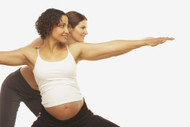As an expecting mother, you constantly receive all kinds of information on how to stay healthy while pregnant. You hear about what foods you should eat, what you can’t eat, what habits you need to quit, which ones you need to start, etc. It can get a little overwhelming.
One question a lot of expecting mothers ask is, “Should I be exercising?” And if so, what does exercising entail? During pregnancy, there’s an apparent need to take things a little slower than usual, be a bit more cautious and practice mindfulness in how you treat your body. Exercising is no exception. Still, this doesn’t mean expecting mothers can’t exercise; in fact, quite the opposite—exercising is encouraged. So, what exactly does that look like? Let’s dive deeper into the why, what and how of exercising while pregnant.
First: the why. Why does exercising during pregnancy matter? Especially for women who may not have been habitual exercisers beforehand, why should they start now? WebMD states, “Regular exercise during pregnancy can improve your posture and decrease some common discomforts such as backaches and fatigue.” In fact, “There is evidence that physical activity may prevent gestational diabetes… relieve stress and build more stamina needed for labor and delivery.” Exercising while pregnant has been shown to have a plethora of benefits, such as:
●Reducing backaches, constipation, bloating and swelling.
●Preventing, or treating, gestational diabetes.
●Increasing energy.
●Improving mood.
●Improving posture.
●Promoting muscle tone, strength and endurance.
●Supporting better sleep.
●Improving ability to cope with labor.
As with most periods of life, regular exercise not only can help improve your physical condition during pregnancy, but also your mental and emotional state, making your pregnancy more enjoyable and your postpartum recovery easier.
The most common question many women ask about exercising during pregnancy is: “Is it safe?” Overall and in most cases, the answer is yes. Alejandro Lucia, a professor of exercise physiology at the European University of Madrid, states, “Within reason, with adequate cautions, it’s important for [everyone] to get over this fear.” According to NPR, among today’s top researchers, there is a strong consensus of exercising benefits for both the mother and developing fetus. According to the American College of Obstetricians and Gynecologists, pregnant women without major medical or obstetric complications should get at least 20 to 30 minutes of moderate exercise most days of the week. Even for women who didn’t particularly exercise before pregnancy, many researchers believe now is the ideal time to start.
Of course, to be safe, exercising while pregnant should be kept within reason. The key to safe exercise while pregnancy is moderation. Avoid any exercise that includes blunt trauma activities, intense weight training or makes your heart pump at 90% or more of its maximum beats per minute. However, all women are different, so it’s important to talk with your healthcare provider early-on, to see what type of exercise works best for you, and how it can best adapt to your current lifestyle; for example, if you weren’t exercising before, it might be better to start at 15 minutes per day.
So, how can you exercise while pregnant? What strategies help get your heart rate up, while still staying safe? Here are a few ideas:
●Walking. Walking is one of the best exercises possible for pregnant women. Walking easily keeps you fit without hurting your knees or ankles, and is safe to do throughout all nine months of pregnancy.
●Running. While intense, long runs might not always be advisable, slow and short-distance jogging is definitely beneficial for expecting mothers. Running is the perfect way to get your heart rate up and build endurance during pregnancy, whether you’re a veteran runner or a newbie.
●Swimming. Swimming is commonly referred to as the best and safest exercise for pregnant women. Not only does it work out your large muscle groups like arms and legs, but it also provides cardiovascular benefits, reduces swelling and can be especially helpful for lower back pain.
●Yoga. Many women do yoga throughout their entire pregnancy. Yoga helps maintain muscle tone and keep you flexible with little to no impact on your joints. It also gets you moving and exercising, without putting too much strain on your heart.
●Aerobics. Aerobic exercise strengthens your heart and tones your body. It can also be fun to do in a dance or interactive environment. Plus, some facilities offer pregnant aerobic classes, which can be a great way to build camaraderie with other moms.
Exercising while pregnant might seem overwhelming, or at times even unsafe. However, experts agree not only can it be extremely beneficial for you, but it can also have amazing health benefits for your baby. Check with your healthcare provider to learn more about the why, what and how of exercising while you’re pregnant.
